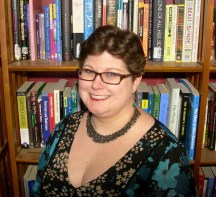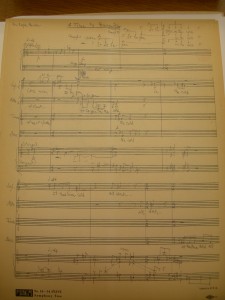Featured Guest Blogger: Kendra Preston Leonard
 Today we feature the second installment in our Featured Guest Blogger series, again focusing on the work of Kendra Preston Leonard and her new book on Lousie Talma. Leonard is a musicologist whose work focuses on women and music in the twentieth and twenty-first centuries; music and screen history, and music and disability. Kendra Preston Leonard is the Director of the Silent Film Sound and Music Archive. The intro chapter to Leonard’s book on Talma is available as a PDF, or through Amazon with the Kindle App. The essay below is drawn from the book, but also from Leonard’s other research.
Today we feature the second installment in our Featured Guest Blogger series, again focusing on the work of Kendra Preston Leonard and her new book on Lousie Talma. Leonard is a musicologist whose work focuses on women and music in the twentieth and twenty-first centuries; music and screen history, and music and disability. Kendra Preston Leonard is the Director of the Silent Film Sound and Music Archive. The intro chapter to Leonard’s book on Talma is available as a PDF, or through Amazon with the Kindle App. The essay below is drawn from the book, but also from Leonard’s other research.
A devout Catholic and social progressive, Louise Talma was devastated by John F. Kennedy’s death, and immediately began commemorating the president in her music. Her first work of commemoration was her piano concerto Dialogues, which was premiered in December 1965 by pianist Grant Johannesen and the Buffalo Orchestra led by Lukas Foss. A response to Kennedy’s unfinished plans, all five of the piece’s movements, “Challenge,” “Struggle,” “Respite,” “Pursuit,” and “Peace,” are focused on the creation and completion of patterns. Shortly after completing Dialogues, however, Talma turned to her favored idiom of voice and began composing A Time to Remember for orchestra and mixed chorus.
After considering a variety of sources by and about Kennedy, Talma selected texts taken from Kennedy’s own speeches (written by both Kennedy himself and by Ted Sorensen), Arthur Schlesinger’s book A Thousand Days, and the bible. Talma experimented with literal space by scoring the work for “three spatially separated choirs” and chamber orchestra. The work takes the listener through the short-lived Kennedy administration, with heavy emphasis on the sense of loss Talma felt at Kennedy’s assassination and her sense of despair for his unfinished goals. Employing straightforward serialism, axial centricity, and only the briefest hints of tonality, the result is a highly dissonant work that places great emphasis throughout on minor and major seconds and tritones, making near-constant use of the “sigh” motif of Talma’s other sorrowful works. Talma’s practices of dis/continuity—keeping some musical elements present while introducing new ones and dropping others—takes on metamusical meaning as part of a work the emphasizes the abruptness with which Kennedy’s presidency was ended, as well as his continuing influence after his death. Talma fragments and repeats textual phrases in a Gertrude Stein-like way, but instead of creating poetry from the rhythms of the repeated words, this is the sound of a speaker so broken by grief that she cannot speak coherently or move on to new thoughts. Talma uses several unconventional techniques in A Time to Remember, some of which she had previously used in The Alcestiad: the chorus is asked to speak as well as sing, sustain or otherwise vocalize consonants, and stamp their feet as a percussive element. [Read more about The Alcestiad here.]
Talma expresses her personal grief in the work through others’ words, but uses her own well-established gestures connoting sorrow, particularly the descending minor or major second “sigh,” which appears in dozens of her pieces as a marker of sorrow. In a nod to previous funeral works, Talma establishes a dotted rhythm from the outset that is borrowed directly from Chopin’s Marche funèbre: Lento of his Piano Sonata No. 2.
The work’s sections constantly build on and reifies its components. Talma uses the individual figurations to mark divisions within section and to move from one axial center to another. At the same time, she repeats material in soundings that highlight different textures and sonorities, creating multiple levels of dis/continuity. In many sections, the instrumental lines are in frequent counterpoint with the chorus, usually in rhythmic syncopation with the voices, another differing element from the previous rhythmic doublings of the orchestra. The fifth section, an excellent example of Talma’s use of dis/continuity and soundings in multiple strata, focuses on religious and presidential texts and proverbs having to do with action and progress, and is the longest and most traditionally tonal of the piece. It does, however, begin with a non-traditional use of chorus members’ feet as part of the percussion battery. A muffled snare drum begins the section; two measures later Talma asks the chorus to begin a chant using the syllable “Prm,” or “Trm,” rolling the R. At the same time, she writes, “Add the sound of marching feet in uninterrupted quarter notes by sliding the ball of one foot from left to right, raising the heel on the floor. This phrase of four measures is to be repeated over and over in constant crescendo to [measure 302].” In addition to the “intoning chorus,” as Talma calls it, which is made up of whatever chorus members are not singing at any particular moment, Talma divides the choral forces into “Chorus I” and “Chorus II.” So separated, Talma creates lines of counterpoint for each voice with its choral partner in the other group.
With all of its markers of sorrow and distress—minor and major seconds, the “sigh” motif, the use of tritones and long passages of turmoil and dissonance—it is not surprising that Talma viewed the work as a requiem of sorts, programming its premiere on a concert with the Mozart Requiem and Bach’s “Komm Susser Tod.” Allan Hughes, writing for the New York Times, thought A Time to Remember a modest success. “The work has a ceremonial quality about it,” he wrote in his review of its premiere at Hunter College in May 1968, “and is both tasteful and dignified. The music, essentially uncomplicated, is easy to listen to.” He prophesied future performances: “The emotional import of the composition will enhance its appeal to large choral groups” (Allan Hughes, “Choral Work Built on Kennedy Words,” New York Times, May 13, 1968).
Indeed, this piece helped establish Talma’s mature career. She was recognized for working comfortably with a mix of approaches and techniques, much like her contemporaries Copland and Schuman, and received performances and positive reviews. However, the shadow of death, never far from her work or mind, re-entered her life with significant effect, and her late works show her preoccupation with writing music both addressing death and, Talma hoped, that would outlive her and establish her legacy.

